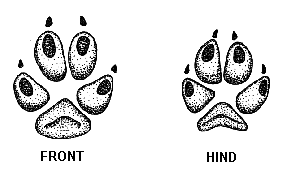
Distribution : The red fox favors to live on
the edges of forests, tilled
fields and near marshes but they can be found on farmland, beaches,
prairies, woodlands and both alpine and arctic tundra. They thrive
throughout most of British Columbia.
Biology : After
a 51-53 day gestation period, up to 10 kits are born.
Because of its well great sense of hearing, sight, and smell the
red fox is an efficient and lethal predator; being an omnivore it eats
whatever is available including corn, berries, apples, grasses, birds and
mammals. The fox has many enemies that include coyotes, the lynx, and
humans. It is also susceptible that they are able to be able to give
off
rabies.
Tracks : The trail of the red
fox generally follows fence lines and the
edges of forests and fields in a straight line but this line may vary
depending on the animals speed and gait. The print is usually smaller,
longer and narrower than that of a dogs. The front print is wider and
larger than the pointed hind print. The heel pad is an inverted V-shape
with a unique calloused ridge across the center of the pad.
Straddle: 8 - 10.5 cm (3.2 - 4.2 in)
Stride: 30 - 40 cm (12 - 16 in)
Track: 5.5 cm (2.2 in) long / 5 cm (2 in) wide

 |
|
| BABY FOX SOUNDS | for more info click here for links |